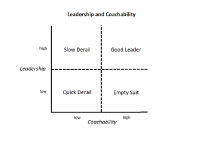Rethinking Leadership Training
05 Sep 2012
Leadership training is a big industry. It is estimated that business spent approximately $60 billion on such training (Peshawaria, 2011) in 2011. This raises two questions. First, why is so much money spent on leadership training? And second, is the money well spent? The answers to both questions are interesting. With regard to the first question, I suspect that leadership training is more about showing respect to certain employees than it is about improving their leadership performance. Being sent to a leadership training course seems to be more of a perk than a response to a perceived need-but, as always, more research is needed. As to whether the money is well spent, the answer is, “Who knows?” No one knows because the literature regarding the evaluation of leadership training is sparse, and that is no accident.
In the absence of empirical data, the issue of leadership trainability can be analyzed logically. The academic literature typically (at least 80% of the time) defines leadership in terms of the people who are in charge (Kaiser, Hogan, & Craig, 2008). This is “the place holder theory of leadership”; it is not very elegant, but it is a theory. Because, in most organizations, people are promoted into leadership positions primarily based on politics and only sometimes based on demonstrated leadership, the lessons learned from a study of placeholders concern how to climb a hierarchy, not how effectively to run an organization. Moreover, defining leadership in terms of place holders is the reason there is so much variability in leadership training curricula.
Drawing on the study of human origins, Van Vugt, Hogan, and Kaiser (2008) propose that leadership is a resource for a group, not a source of privilege for incumbents; in this view, leadership concerns building and maintaining a team that can outperform the competition. The lesson drawn from the study of people who can build effective teams concerns how to persuade normally selfish individuals to work together toward a common goal. Leadership should properly be defined and evaluated in terms of the performance of the followers; in business this performance is usually specified in terms of profitability. A person can rapidly climb the hierarchy of an organization while ruining the teams he/she leads-and still be called a leader-but a person who leads a team to victory is in fact a leader.
Leadership is a skilled performance. We know that talent for performance in any endeavor is normally distributed: some people will be high performers, some will be low performers, and most will be mediocre. It seems reasonable to assume that talent for leadership is normally distributed, and that some people will have more talent for leadership than others. But what is leadership performance? Leadership performance involves building a team by creating team member engagement. And how must a person behave in order to do this? A person must behave so as to be perceived by the team members as having: (1) integrity; (2) good judgment; (3) competence in the activity in which the team is engaged; and (4) an attractive vision for the future of the team.
How do potential leaders persuade their teams that they have integrity, good judgment, competence, and an attractive vision? They do this by putting on a consistent and credible performance that displays probity and astute decision making, demonstrates competence, and explains the vision. However, team members will watch closely for signs that potential leaders lack these characteristics-they watch closely because most leaders lack these characteristics-and every lie, every bad decision, every operational oopsie, and every sign of self-serving behavior will: (a) undermine their claim to legitimate leadership and (b) alienate the team (alienation is the opposite of engagement).
Not every person with athletic talent becomes a good athlete, and not every person with leadership talent becomes a good leader. A major factor in the development of any talent concerns coachability - it is the one thing that all professional athletes have in common. Coachability can be conceptualized in terms of two components: (1) a desire to improve one’s performance; and (2) being responsive to critical feedback. What’s true for the development of athletic talent is true for the development of leadership talent-development depends on being willing to listen to and internalize feedback. This leads to a useful two by two table (photo) as bellow.
Leadership training should follow from one’s theory of leadership. The placeholder theory of leadership suggests that we should train people to lie to and steal ideas, to bully and humiliate subordinates, or to plunder and bankrupt organizations. In contrast, the team builder theory of leadership suggests we should train people to act with integrity, exercise good judgment, become experts in the business, and be able to persuade the team that their goals are worthy.
This analysis also suggests that training money is best spent on people who: (a) have talent for leadership, and (b) are coachable. Because this would be no more than 25% of existing managers, it appears that about 75% of the money spent on leadership training will not be used effectively.
Robert Hogan
Hogan Assessment Systems
References
- Kaiser, R. B., Hogan, R., & Craig, S.B. (2006). Leadership and the fate of organizations. , , 96-110.
- Peshawaria, R. (2011). The great training robbery. Forbes
- Van Vugt, M., Hogan, R., & Kaiser, R. B. (2008). Leadership, followership, and evolution. 63, 182-196.





